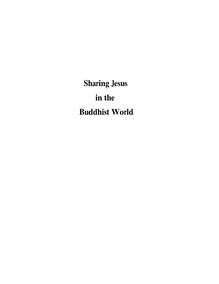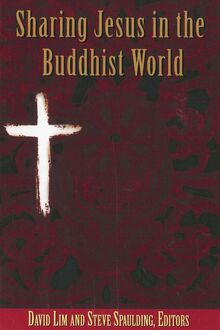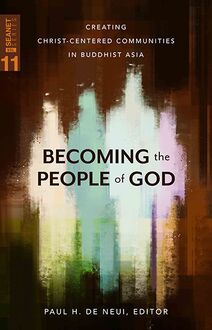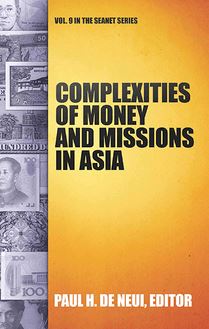-
 Univers
Univers
-
 Ebooks
Ebooks
-
 Livres audio
Livres audio
-
 Presse
Presse
-
 Podcasts
Podcasts
-
 BD
BD
-
 Documents
Documents
-
- Cours
- Révisions
- Ressources pédagogiques
- Sciences de l’éducation
- Manuels scolaires
- Langues
- Travaux de classe
- Annales de BEP
- Etudes supérieures
- Maternelle et primaire
- Fiches de lecture
- Orientation scolaire
- Méthodologie
- Corrigés de devoir
- Annales d’examens et concours
- Annales du bac
- Annales du brevet
- Rapports de stage
La lecture à portée de main
Découvre YouScribe en t'inscrivant gratuitement
Je m'inscrisDécouvre YouScribe en t'inscrivant gratuitement
Je m'inscrisEn savoir plus
En savoir plus

Description
Introduction by David Lim and Steve Spaulding
The Challenging of the Globalization of Buddhism by David Burnett
Elements of a Biblical and Genuine Missionary Encounter with Diaspora Chinese Buddhist in Southeast Asia by Tan Kang San
Missiological Implications of the Key Contrasts Between Buddhism and Christianity by Alex Smith
Suffering and Salvation in Buddhism and Christianity: Negotiations and Positions by Johannes Aagaard
Towards a Radical Contextualization Paradigm in Evangelical Buddhists by David Lim
An Integrated Model of Evangelism to Buddhists Using Theology, Anthropology, and Religious Studies by Ubolwan Mejudhon
Contextualization with Thai Folk Buddhists by Paul De Neui
Communication Strategies for Christian Witness Among the Lao by Stephen Bailey
Anatman as a Metaphor for Japan by Mark Dominey
Sujets
Informations
| Publié par | William Carey Publishing |
| Date de parution | 01 juin 2003 |
| Nombre de lectures | 0 |
| EAN13 | 9781645082156 |
| Langue | English |
Informations légales : prix de location à la page 0,0500€. Cette information est donnée uniquement à titre indicatif conformément à la législation en vigueur.
Extrait
Sharing Jesus
in the
Buddhist World Sharing Jesus
in the
Buddhist World
David Lim and Steve Spaulding, EditorsCopyright 2003 by David Lim and Steve Spaulding
All Rights Reserved
No part of this publication may be reproduced, stored in a retrieval
system, or transmitted in any form or by any means—electronic,
mechanical, photocopy, recording, or any other—except for brief
quotations embodied in critical articles or printed reviews, without
prior permission of the publisher.
Cover design by Rachel Snodderly
Copyediting: Marybeth Tewksbury
Published by
William Carey Library
1605 Elizabeth St.
Pasadena, California 91104
ISBN 0-87808-506-8
Printed in the United States of AmericaContents
Introduction vii
David Lim and Steve Spaulding
The Challenge of the Globalization of Buddhism 1
David Burnett
Elements of a Biblical and Genuine Missionary Encounter 19
with Diaspora Chinese Buddhists in Southeast Asia
Tan Kang-San
Missiological Implications of the Key Contrasts between 31
Buddhism and Christianity
Alex Smith
Suffering and Salvation in Buddhism and Christianity: 57
Negations and Positions
Johannes Aagaard
Towards a Radical Contextualization Paradigm 71
in Evangelizing Buddhists
David S. Lim, Ph.D.
An Integrated Model of Evangelism to Buddhists 95
Using Theology, Anthropology, and Religious Studies
Ubolwan Mejudhon
vvi SHARING JESUS IN THE BUDDHIST WORLD
Contextualizing with Thai Folk Buddhists 121
Paul H. DeNeui
Communication Strategies for Christian Witness 147
among the Lao
Stephen Bailey
Problem of Japanese Self-Identity 173
Mark DomineyIntroduction
David Lim and Steve Spaulding
A group of evangelical mission theologians and practitioners who are
concerned with developing more biblical and effective ways to evangelize in
the Buddhist world are instrumental in having this book produced. Our
objective is to bring together a set of well-researched works that will
help the global church reach the peoples in the Buddhist megasphere
for Christ.
We hope we can publish one similar book per year through the
annual holding of a missiological forum that specifically focuses on
this theme. We thank God that we were able to hold the first Forum
at the start of the fourth assembly of SEANET last March 18-19,
2002, in Bangkok, Thailand.
For the past three years, SEANET had been holding annual
assemblies that brought together various key leaders (church leaders, mission
leaders, missiologists, missionaries, and pastors) to reflect, discuss, and
plan programs and projects that will help in the evangelization of
Buddhist peoples and nations. Even in the first assembly, the group already
discerned that there needs to be three strategic foci for our consideration:
(1) prayer mobilization,
(2) research and training, and
(3) strategy development.
viiviii SHARING JESUS IN THE BUDDHIST WORLD
It was during the 2000 assembly that the idea surfaced of holding a
regular missiological forum (with its papers published widely) to provide
the global church with knowledge and understanding of the Buddhist
world and how to reach it for Christ. No one was ready to put it into
action then, but in the 2001 assembly, David Lim accepted the
challenge to get it organized, while the Steering Group (led by Steve
Spaulding) committed itself to finding the resources to help make it
happen. We praise God that we found a foundation (which humbly
asked not to be recognized) that was more than willing to provide all
the funds needed for the event and the publication of its papers!
For the forum, fifteen evangelical researchers, theologians, and
missiologists were asked to contribute a paper each. Ten accepted to try,
and nine made it. And what an impressive combination of excellent
and creative works they were! These were received very well by the more
than forty people who registered (we were expecting only fifteen to
twenty participants to start with!). We hope that the publication of
these papers in a book will be warmly welcomed and appreciated by the
global church.
The nine papers in this compendium have three major themes:
(1) One is a “situationer” on the global context of the Buddhist
world. David Burnett, who heads the Center for Buddhist
Studies at All Nations, U.K., presents this paper on “The
Challenge of Globalization of Buddhism,” which shows the
historical contextualizations that Buddhism has undergone since
its beginnings to the present.
(2) Four papers are on the second theme: “Issues in Theological
Contextualization,” that is, how do we engage the Buddhist
worldview in the twenty-first century.
(a) Kang San Tan, a Chinese missiologist based in Malaysia,
outlines the “Elements of a Biblical and Genuine
Missionary Encounter with Diaspora Chinese Buddhists.”
(b) Alex Smith, an OMF missionary in Thailand for almost
thirty years, shows the “Missiological Implications of the Key
Contrasts Between Buddhism and Christianity,” while Introduction ix
(c) Johannes Aagaard, head of the Dialog Center in Denmark,
which reaches out to Buddhists worldwide, presents his
“Reflections on Suffering and Salvation in Buddhism and
Christianity.” And
(d) David Lim, a biblical theologian cum mission mobilizer
who has ministered among the Chinese Diaspora in the
Philippines, gives the challenge to work “Towards a
Radical Contextualization Paradigm in Evangelizing
Buddhists.”
(3) The other four papers are missiological reflections on “case
studies” of actual missions to Buddhists. Two are on our host
culture in Thailand:
(a) Dr. Ubolwan Mejudhon, who heads the Cross-Cultural
Communication Training Center and the Muangthai
Church in Bangkok with her husband, presents “An
Integrated Model of Evangelism to Buddhists Using Theology,
Anthropology, and Religious Studies,” the result of a
nine-year research for her D. Miss. with Asbury
Seminary. And
(b) Paul DeNeui, a missionary in Thailand, now finishing
his D. Miss. at Fuller Seminary, narrates with his colleague,
the head of the Isaan Covenant Church, how they did
“Contextualizing with Thai Folk Buddhists.”
Then on another folk Theravadan context,
(c) Steve Bailey shares his model of “Communication Strategies
for Christian Witness among the Lao.” Finally,
(d) Mark Dominey, an OMF missionary who has a D. Miss.
from Dallas Seminary, shows the challenge of the “Problem
of Japanese Self-Identity.”
During the forum, some more issues were raised for future fora.
These may be classified into two main sets:
(1) On theological challenges are: limits to contextualization, value
and limits to dialogue, Tantric Buddhism, “transfer of merit”x SHARING JESUS IN THE BUDDHIST WORLD
in folk Buddhism, “theology of suffering” compared, and new
Buddhist religious movements. Three papers in this area have
also been volunteered: “The Use of Ecclesiastes in Evangelizing
Buddhists,” “Christian Creation Worldview for University
Students in Buddhist Contexts,” and “The Attraction of
Buddhism in the West and How to Respond.”
(2) The second set consists of (practical) missiological models.
Among them are: “Spiritual Perspectives in Evangelizing
Buddhists in South Asia,” “How to Facilitate Group Decisions for
(Birthing) People Movements,” “Implications for Theological
Education,” “Identity and Role of Expatriate Missionaries,” and
some general topics like: indigenous arts and communication,
conversion of monks, models of partnership, and models of
church-planting movements (CPMs).
Also requested are papers to give “situationers” on Buddhism in
Asia, in the West, and especially on Buddhist persecution of Christians.
All these look very promising for a second book, to come next year.
Readers who are interested in participating in the Forum and/or this
publication series may contact the publishers.
Please pray and work with us as we look forward to an annual
forum on Christian missions to the Buddhist world, as well as an annual
publication of the papers presented in each forum. May God find our
circle of partners and colleagues faithful in facilitating the sharing of the
“best theologies” and the “best practices” of Christians, particularly
evangelicals worldwide, in reaching Buddhist peoples for Christ in their
various contexts—until all shall hear and have a chance to be saved.
DAVID LIM and STEVE SPAULDING, editors
Quezon City, Philippines
June 4, 2002The Challenge
of the Globalization of Buddhism
David Burnett
Most religions experience a tension between the desire to hold to the
original patterns of their founders, and the need to innovate to
accommodate changing situations. This is because religions emerge from one
historical and social context and generally address the needs of that
particular situation. However, religious aspirations are never exclusive to
one community, so the teaching and practice has the potential to spread
into similar societies. As they spread beyond their original community
there is a continual process of reinterpretation and adaptation. Thus,
missionary religions are continually faced with the dilemma of holding to
traditions or contextualizing to the new. In order for a new religion to
expand, it must allow freedom for local expressions.
This paper first examines the reasons for the early expansion of
dharma in India. Second, it considers the process of contextualization of
Indian Buddhism to China. Third, the analysis will look at the way
Buddhism has entered Western society, and explore the contemporary
process of adaptation that is currently taking place.
Expansion of Buddhism in India
This paper argues that Buddhism has been more open to adaptation
than most religions. This is probably because Buddhism is not merely
12 SHARING JESUS IN THE BUDDHIST WORLD
a philosophy, but a religious discipline that leads to an awakening to the
true nature of reality. The Buddha taught that by direct experience he
had come to understand the human condition, and had discovered a means
of transcending it. The human condition is one of continual rebirth into
samsar
-
 Univers
Univers
-
 Ebooks
Ebooks
-
 Livres audio
Livres audio
-
 Presse
Presse
-
 Podcasts
Podcasts
-
 BD
BD
-
 Documents
Documents
-
Jeunesse
-
Littérature
-
Ressources professionnelles
-
Santé et bien-être
-
Savoirs
-
Education
-
Loisirs et hobbies
-
Art, musique et cinéma
-
Actualité et débat de société
-
Jeunesse
-
Littérature
-
Ressources professionnelles
-
Santé et bien-être
-
Savoirs
-
Education
-
Loisirs et hobbies
-
Art, musique et cinéma
-
Actualité et débat de société
-
Actualités
-
Lifestyle
-
Presse jeunesse
-
Presse professionnelle
-
Pratique
-
Presse sportive
-
Presse internationale
-
Culture & Médias
-
Action et Aventures
-
Science-fiction et Fantasy
-
Société
-
Jeunesse
-
Littérature
-
Ressources professionnelles
-
Santé et bien-être
-
Savoirs
-
Education
-
Loisirs et hobbies
-
Art, musique et cinéma
-
Actualité et débat de société
- Cours
- Révisions
- Ressources pédagogiques
- Sciences de l’éducation
- Manuels scolaires
- Langues
- Travaux de classe
- Annales de BEP
- Etudes supérieures
- Maternelle et primaire
- Fiches de lecture
- Orientation scolaire
- Méthodologie
- Corrigés de devoir
- Annales d’examens et concours
- Annales du bac
- Annales du brevet
- Rapports de stage









